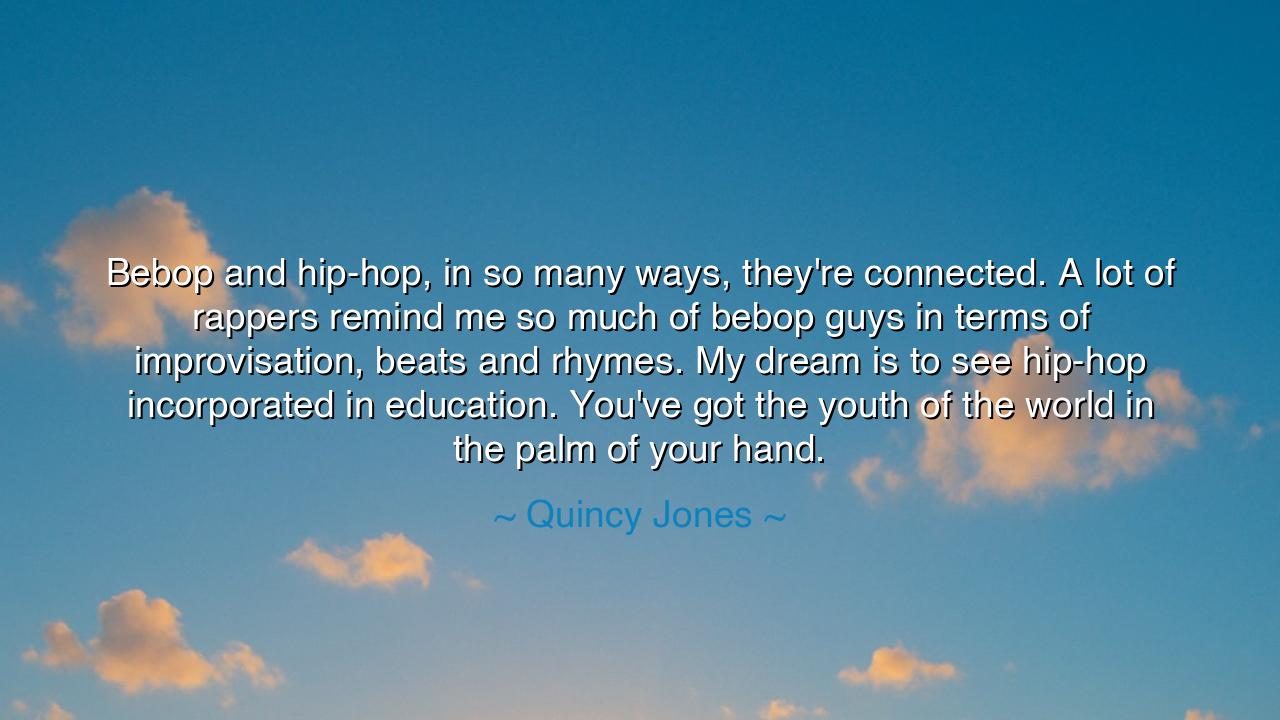
Bebop and hip-hop, in so many ways, they're connected. A lot of
Bebop and hip-hop, in so many ways, they're connected. A lot of rappers remind me so much of bebop guys in terms of improvisation, beats and rhymes. My dream is to see hip-hop incorporated in education. You've got the youth of the world in the palm of your hand.






Quincy Jones, a master who walked with the giants of music, once declared: “Bebop and hip-hop, in so many ways, they’re connected. A lot of rappers remind me so much of bebop guys in terms of improvisation, beats and rhymes. My dream is to see hip-hop incorporated in education. You’ve got the youth of the world in the palm of your hand.” In these words shines not only the wisdom of an artist, but the vision of a prophet. He calls us to see music not merely as entertainment, but as a bridge across time, a lineage of rhythm and word, and as a tool to awaken the minds of the young.
The origin of this truth lies in the deep river of African-American creativity. Bebop, born in the 1940s through figures like Charlie Parker and Dizzy Gillespie, was the music of rebellion and imagination. It broke away from rigid forms and dared to improvise, to weave new patterns from familiar chords, to create beauty in flight. Decades later, hip-hop arose in the streets of New York, a new form of rebellion, poetry upon the beat, storytelling in rhythm. Both movements were dismissed at first as noise, as unruly, as dangerous. Yet both contained the same spark of genius: the power of improvisation, of freedom within structure, of the voice refusing to be silenced.
Consider the kinship of a bebop solo and a rap verse. In bebop, the saxophone races through impossible phrases, inventing in the moment. In hip-hop, the rapper freestyles, bending rhymes and words to command the beat. In both, the performer risks everything on the edge of the unknown, trusting instinct, memory, and soul. Quincy Jones, who stood at the crossroads of jazz and modern music, recognized this kinship. His words remind us that art forms separated by time are in truth branches of the same tree.
But Jones does not stop with art; he sees destiny. “My dream,” he says, “is to see hip-hop incorporated in education.” For what is education if not the drawing out of a person’s potential? If you wish to reach the youth, you must speak their language, and today their language is the beat, the rhyme, the flow. Just as Plato once used dialogue to awaken truth in the young, so can modern teachers use hip-hop to awaken critical thinking, storytelling, and self-expression. Jones reminds us that when you harness the art of a generation, you hold their attention, their imagination, and their future in the palm of your hand.
History gives us examples of this vision in action. In South Africa, during the final years of apartheid, protest songs became lessons, teaching courage and unity. In America, the spoken word poetry of the Harlem Renaissance awakened pride and intellectual fire in a generation that had been silenced. In the same way, hip-hop, when brought into the classroom, can teach rhythm, language, history, and the power of voice. What the textbook cannot reach, the rhyme may ignite. What the lecture cannot stir, the beat may awaken.
The deeper meaning is this: education must not be fossilized, but living. The goal is not to impose dead knowledge, but to cultivate living wisdom. If hip-hop has captured the youth, then it must not be cast aside as trivial, but harnessed as sacred fire. For the energy of the young, if ignored, becomes destructive; but if directed, becomes creative power. To incorporate their art into learning is not surrender, but transformation—turning the raw energy of the street into the disciplined energy of the mind.
The lesson for us is urgent: never despise the art of the young. What seems rebellious today may be the seed of tomorrow’s genius. Just as bebop once scandalized the elders, and now is revered as high art, so too may hip-hop prove to be the educational tool of the century. If you are a teacher, seek ways to weave rhythm and rhyme into your lessons. If you are a leader, support the arts, for they carry the future in their pulse. If you are among the youth, do not doubt that your music has power—power to educate, to inspire, to build.
Thus Quincy Jones’ words echo like a call across generations: bebop and hip-hop are brothers in the great lineage of freedom. And when hip-hop joins hands with education, the result is not only music but transformation. For in the beat lies the heart of the youth, and in the youth lies the destiny of the world. Let us, therefore, honor the music, embrace the dream, and awaken the future.






AAdministratorAdministrator
Welcome, honored guests. Please leave a comment, we will respond soon